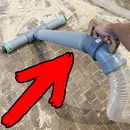Introduction: Plywood Pet Carrier
Have you ever wondered how to make a carrying crate for your pet out of plywood and few bits and pieces? Well, wonder no more as in this instructable I will demonstrate to you how I made one for my cat for under 20€.
The idea emerged when I was visiting my local plywood supplier. As I was talking to the guys I noticed a corner full of cutoffs and scraps. Of course, my first thought was to acquire some of this material for future projects. The guys had no problem with it and for 10€ I got enough material to build a crate you are seeing here. From the hardware store, I got the rest of the components for 5€
This project is a great one for intermediate woodworkers. It does not require many complex tools but it will require a lot of patience as one will be dealing with many delicate pieces that need a lot of attention. It is also a great project to try out plywood bending (it is easier than you think). This was actually my first time as well. Let me know in the comments what you think!
Let´s get started!
Step 1: Tools and Materials
Materials needed for this build are:
- Plywood(9mm or similar) 40cm wide and 100cm in length.
- Plywood (4mm or similar) 40cm wide 75cm in length. The idea here is that it has to be flexible. Know that thin plywood is more flexible in one direction than other (usually the one that has more perpendicular running layers)
- A pair of hinges (brass matches well with plywood!). I could not find brass ones so I got a piano hinge.
- A latch to close the door and keep your pet inside. (Again, I would have used a brass one but my local hardware store did not have any)
- 4 rubber feet
- Small screws for attaching the hardware
- Small nails
- Fabric for the handle (5X30cm piece)
- 2 furniture bolts, 2 large washers, 2 nuts (for attaching the handle)
- Spray lacquer for the finish
- Spray adhesive for making the handle (or you can sew it)
- Wood putty for imperfections
Wood glue
Tools needed are:
- Table saw
- Scroll saw
- Disc sander
- Router with a straight bit
- Ryoba saw (flush trim hand saw)
- Drill with wood bits
- Clamps (both big and small ones)
- Hammer
- Screwdriver
- Marking tools
- Scissors
- Ruler/tape measure
I think from power tools only must-have is a scroll saw (or jigsaw) and drill - all other tools just make your life a whole lot easier. Do not forget- the best tools are the ones you have so be creative!
Step 2: Cutting the Material
The first step is to cut the material to the correct size. On the table saw it will go like breeze.
The piece sizes are as follows:
- Bottom 40x25cm
- Front and back 30X25 cm
- Horizontal strips 40X1cm. In order for the cage to be lightweight one has to make the strips as thin as possible. I made my strips 1cm wide and attached them with a distance of 3 cm from each other.
- Vertical strips are around 75X2cm. You can not see them in the photos as I cut them later on in the project.
Use a scroll saw to cut a round outer shape on both front and back. Use a piece of paper to make a template and just copy right and left side to get symmetrical shape. It is a good idea to tape both pieces together before cutting. This way they will be identical. Use double-sided tape or regular paper tape as I did to hold the pieces together. I used my homemade bandsaw to make the round cut just because it was faster. After that, I used my disc sander (also homemade ;) to refine the shape.
Step 3: Adding a Rabbet to the Edges (optional)
Adding a rabbet to the edges of the front and back piece will create a larger glue surface and thus make the whole construction stronger. It will also help to align the horizontal strips which is really really useful!
I used a straight bit and a router fence on my plunge router to create a rabbet a material's thickness wide and half a thickness deep.
Step 4: Door and Pattern
I traced a line 3cm from the edge to create a door bearing in mind the latch and hinges positions. I used a scroll saw to cut it out.
After I had the door ready I drew a grid pattern on both the door and the backside. I decided to make the pattern similar to one that will be on the sides. Hole size 2X3 cm.
Next, I used a drill with a wooden bit to create a hole through which I would insert the scroll saw blade. Talking about the scrolling - boy was this hard! Well, it was not really hard but just very monotonous. Attaching the blade, cutting out the rectangle, detaching the blade: 50+ times (depending of course on how fine your pattern is).
As the weather was really nice I decided to take my scroll saw outside to get some sun while scrolling :)
After scrolling, I refined the shape a little with a file to get rid of saw marks.
If you are not a big fan of scrolling then you could also just drill nice looking holes using a spade bit. This look would not match the rest of the crate but would surely be much less time-consuming.
Step 5: The Horizontal Strips
First I attached the front and back to the bottom piece using a brad nailer! Do not, I repeat do not give in to the temptation of using power nailer in this project! I did it a few times and the results were devastating - it split the pieces and created much more work than needed. Instead, simply go with small nails and a hammer. It will not guarantee a flawless work but the success rate is tremendously higher.
The horizontal strips I first glued and then used a nail on each end to reinforce the glue joint. I used a 3cm wide spacer to get the distance between pieces equal all the way around. I started glueing the strips from both sides at the same time. This resulted in two strips being really close to each other on the top which was just perfect for later attaching the handle.
Step 6: The Vertical Strips
On the table saw I cut a bunch of strips from the thin plywood. the width of the cut was set around 2 cm (two times the thickness of the thicker plywood). After a quick sand to remove rough edges I attached them on one side of the crate. I do not really know if it was the best idea to attach them all at the same time since they impeded a little the glueing process. The other solution would be just to do one strip at the time.
The glueing process itself started on one end and was also quite time-consuming. First I applied some water on the middle section of the strip. This ensured that it would not break while being bent over the tight radius. Next, I added glue to all the joints where the vertical strips would meet the horizontal ones. Then I pulled the other end tight against the crate and added a nail. I checked the distance between strips with a spacer and added spring clamps. I did not have that problem but when you see that the vertical strip are not tight against all horizontal strips then the solution is to add the clamps first starting from the already attached end and then finishing off with the nail.
The strips on both ends I nailed all the way around to give some extra strength. After the glue had dried I cut off the overhang of the strips with a ryoba saw.
The spring clamps you see me use are actually quite big and not too pleasant to work with. I really should invest in a bunch of smaller spring clamps.
Step 7: Sanding and Finishing
Before the final sanding, I filled all the voids and imperfections with wood putty.
Using an eccentric sander and regular sandpaper I gave the crate a good sanding.
I hung it from the ceiling using a rope and applied two coats of matt spray lacquer.
Step 8: Adding the Hardware
Nothing special about this. Just marked the hole locations, predrilled and added the screws!
I did not really have screws short enough so I sanded the tip of the screws off on the disc sander. You do not really need the pointy tip anyway once you have predrilled the material!
Simple rubber feet on the bottom added grip and raised the crate slightly off the floor.
Step 9: The Handle
And the last but not least was to make a handle to comfortably carry the crate. There are probably a million ways to make a handle but I decided to with this leather-like look. I used synthetic leather for this.
First I cut a piece of fabric that measured 5X30 cm. This would create a handle 2.5 cm wide which would feel the most comfortable in hand. Next, I applied spray adhesive on the backside and allowed it to cure a little before folding sides to the middle. You could just sew it if you are good with a needle and a thread.
I attached the handle using two furniture bolts. I actually used a drill to make a hole in the fabric but a circle punch would work much better for this. The little space between the two topmost pieces was ideal and I did not have to drill into any wood for attaching the handle.
Step 10: The End!
And this is it! I hope you like my crate design and have maybe learned something from my article. I definitely enjoyed making it and think my cat Nurris loves it too! To be honest this was my very first "round" wooden project. That in mind I would say that it turned out pretty darn well! Or what do you think?
Feel free to leave a comment or a suggestion down below and do not hesitate to ask if something was unclear!
I would be super happy if you voted for me in the Pets 2019 contest! Thanks!
All the best,
Andu

First Prize in the
Pets Challenge













